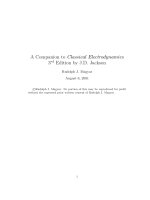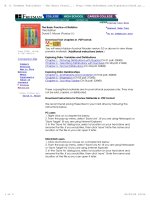Biochemistry (mathews 3rd ed)
Bạn đang xem bản rút gọn của tài liệu. Xem và tải ngay bản đầy đủ của tài liệu tại đây (34.33 MB, 2,464 trang )
Welcome to the Companion Web Site that accompanies the third edition of Biochemistry by Mathews,
van Holde, and Ahern. At a time when major technological advances are occurring in both electronics
and biochemistry, it is fitting that a web site accompanies this important biochemistry textbook.
Companion Web Site Requirements
To fully utilize this Companion Web Site it is important to understand the requirements.
Get Started!
Click on one of the chapters in the "choose a chapter" table to the left.
Features of This Companion Web Site
Each chapter in the textbook has a corresponding section on the Companion Web Site that contains
Outlines, Concepts, Terminology, and Quizzing to help you succeed in your Biochemistry course.
● Outlines sections parallel the organization of the individual chapters in the textbook, with
hyperlinks to key concepts, figures, and pathways.
● Concepts sections contain hyperlinked summaries of the important concepts from each chapter.
● Terminology sections, which define the important terms from the text on a chapter-by-chapter
basis, also include hyperlinks to appropriate figures.
● Quizzing sections help you learn and retain the numerous terms, names, structures, enzymes, and
pathways encountered in biochemistry. The Quizzing sections contain over 6000 queries to give
you a thorough review and to make it possible to return many times without encountering the
same question twice.
CD-ROM Access
When you're not on-line you can continue your study of biochemistry by using the CD-ROM found in the
back of the book. The material available on this web site can also be found on the CD-ROM.
Connectivity to Expanded Information on the Internet
The internet provides an incredible amount of information in Biochemistry. We have included hyperlinks
between the concepts, enzymes, and molecules covered on the Companion Web Site to related
information found on hundreds of external web sites. In doing so, the Companion Web Site provides an
intellectual bridge between the textbook and an evolving body of knowledge that will undoubtedly grow
with time, making this site a tool for learning biochemistry and an ongoing reference.
Outline
Introduction (Figure 1.1)
Revolution in biological sciences
Designing Molecules
6-Mercaptopurine
3'-Azido-2',3'-dideoxythymidine (AZT)
Isoproterenol
What is Biochemistry?
Goals of Biochemistry
Describe structure, organization, function of cells in molecular terms.
Structural Chemistry
Metabolism
Molecular Genetics
Roots of Biochemistry (Figure 1.3)
Wohler's synthesis of urea
Buchners' fermentation of sugar from yeast extracts
Sumner's crystallization of urease
Flemming's discovery of chromosomes
Mendel's characterization of genes
Miescher's isolation of nucleic acids
Watson and Crick's structure of DNA
Biochemistry as a Discipline
Biochemistry as a Chemical Science
Amino acids
Sugars
Lipids
Nucleotides
Vitamins
Hormones
Chemical Elements of Living Matter(Figure 1.4, Table 1.1)
Biological Molecules
Monomers/Polymers (Figure 1.7)
Sugar/Polysaccharide
Nucleotide/Nucleic Acids
Amino acid/Polypeptides (Figure 1.6)
Biochemistry as a Biological Science
Distinguishing Characteristics of Living Matter
Constant renewal of a highly ordered structure accompanied by an increase in
complexity of that structure
Overcoming entropy requires energy
Life is self-replicating
Unit of Biological Organization: The Cell (Figure 1.8, Figure 1.9)
Prokaryotes (Table 1.2)
Eubacteria
Archaebacteria
Eukaryotes (Compartmentalization of organelles) (Figure 1.11, Figure 1.13)
Windows on Cellular Functions: The Viruses
New Tools in the Biological Revolution(Figure 1.15)
The Uses of Biochemistry
Agriculture
Medicine
Nutrition
Clinical Chemistry
Pharmacology
Toxicology
Outline
Introduction (Figure 1.1)
Revolution in biological sciences
Designing Molecules
6-Mercaptopurine
3'-Azido-2',3'-dideoxythymidine (AZT)
Isoproterenol
What is Biochemistry?
Goals of Biochemistry
Describe structure, organization, function of cells in molecular terms.
Structural Chemistry
Metabolism
Molecular Genetics
Roots of Biochemistry (Figure 1.3)
Wohler's synthesis of urea
Buchners' fermentation of sugar from yeast extracts
Sumner's crystallization of urease
Flemming's discovery of chromosomes
Mendel's characterization of genes
Miescher's isolation of nucleic acids
Watson and Crick's structure of DNA
Biochemistry as a Discipline
Biochemistry as a Chemical Science
Amino acids
Sugars
Lipids
Nucleotides
Vitamins
Hormones
Chemical Elements of Living Matter(Figure 1.4, Table 1.1)
Biological Molecules
Monomers/Polymers (Figure 1.7)
Sugar/Polysaccharide
Nucleotide/Nucleic Acids
Amino acid/Polypeptides (Figure 1.6)
Biochemistry as a Biological Science
Distinguishing Characteristics of Living Matter
Constant renewal of a highly ordered structure accompanied by an increase
in complexity of that structure
Overcoming entropy requires energy
Life is self-replicating
Unit of Biological Organization: The Cell (Figure 1.8, Figure 1.9)
Prokaryotes (Table 1.2)
Eubacteria
Archaebacteria
Eukaryotes (Compartmentalization of organelles) (Figure 1.11, Figure
1.13)
Windows on Cellular Functions: The Viruses
New Tools in the Biological Revolution(Figure 1.15)
The Uses of Biochemistry
Agriculture
Medicine
Nutrition
Clinical Chemistry
Pharmacology
Toxicology
Figure 1.1: Medical applications of biochemistry.
6-Mercaptopurine
6-Mercaptopurine is an analog of hypoxanthine, an
intermediate in purine nucleotide biosynthesis. When
mercaptopurine is made into a
nucleotide by a cell, it stops
DNA replication from occurring because it is incorporated
into DNA by DNA polymerase instead of the proper
nucleotide.
6-Mercaptopurine is an anticancer medication. It inhibits the
uncontrolled DNA replication associated with proliferation of
white blood cells in leukemia.
See also: DNA, Purines, De Novo Biosynthesis of Purine
Nucleotides, DNA Replication Overview
Hypoxanthine
Hypoxanthine is a base found in an intermediate of purine
nucleotide biosynthesis. Figure 22.4 summarizes the pathway
leading from phosphoribosyl-1-pyrophosphate (
PRPP) to the first
fully formed purine nucleotide, inosine 5'-monophosphate (
IMP),
also called inosinic acid. IMP contains as its base, hypoxanthine.
Hypoxanthine is also a product of catabolism of purine nucleotides (Figure 22.7). Hypoxanthine can be
converted to xanthine by the enzyme
xanthine oxidase in the reaction that follows:
Hypoxanthine + O2 <=> Xanthine + H2O2
In addition, hypoxanthine can be converted back to IMP in purine nucleotide salvage biosynthesis (by
the enzyme HGPRT), as shown in Figure 22.9.
Complete deficiency of HGPRT results in gout-related arthritis, dramatic malfunction of the nervous
system, behavioral disorders, learning disability, and hostile or aggressive behavior, often self directed.
In the most extreme cases, patients nibble at their fingertips or, if restrained, their lips, causing severe
self-mutilation.
Allopurinol, which is similar to hypoxanthine (see here), is used to treat gout because it inhibits
xanthine oxidase, leading to accumulation of hypoxanthine and xanthine, both of which are more
soluble and more readily excreted than
uric acid, the chemical that causes gout.
See also: De Novo Biosynthesis of Purine Nucleotides, Purine Degradation, Excessive Uric Acid in
Purine Degradation, Salvage Routes to Deoxyribonucleotide Synthesis, Nucleotide Analogs in
Selection
INTERNET LINKS:
1. Purine Metabolism
2. Purine and Pyrimidine Metabolism
Figure 22.4: De novo biosynthesis of the purine ring, from PRPP to inosinic acid.
Phosphoribosyl Pyrophosphate (PRPP)
PRPP is an intermediate in nucleotide
metabolism. It is found in several de
novo and salvage pathways. PRPP is
formed by action of the enzyme, PRPP
Synthetase, as follows:
ATP + Ribose-5-Phosphate <=>
PRPP +
AMP
Enzymes that act on PRPP include
Phosphoribosyltransferases (salvage
synthesis and de novo synthesis of
pyrimidines),
PRPP amidotransferase
(de novo purine synthesis)
See also: De Novo Biosynthesis of Purine Nucleotides, De Novo Pyrimidine Nucleotide Metabolism,
Nucleotide Salvage Synthesis
Phosphribosyl Pyrophosphate Synthetase (PRPP Synthetase)
PRPP synthetase is an enzyme that catalyzes there reaction below (see here also):
ATP + Ribose-5-Phosphate <=> PRPP + AMP
PRPP is an important intermediate in the de novo synthesis of purines pathway (Figure 22.4). Defects
in PRPP synthetase may render it insensitive to feedback inhibition by purine nucleotides. Thus, purine
nucleotides are overproduced, leading to excessive
uric acid synthesis and gout (Figure 22.9).
See also: The Importance of PRPP, De Novo Biosynthesis of Purine Nucleotides, Excessive Uric
Acid in Purine Degradation
Unnumbered Item
Adenosine Triphosphate (ATP)
ATP serves as the
general "free energy
currency" for virtually
all cellular processes.
Hydrolysis of ATP is
used to drive
countless biochemical
reactions, including
many that are not
phosphorylations. It is
a direct source of
energy for cell
motility, muscle
contraction, and the
specific transport of substances across membranes. The processes of photosynthesis and metabolism of
nutrients are used mainly to produce ATP. It is probably no exaggeration to call ATP the single most
important substance in biochemistry. The average adult human generates enough metabolic energy to
synthesize his or her own weight in ATP every day.
ATP is produced in the cell from ADP as a result of three types of phosphorylations - substrate-level
phosphorylations, oxidative phosphorylation, and, in plants, photosynthetic phosphorylation.
ATP is a source of phosphate energy for synthesis of the other nucleoside triphosphates via the reaction
that follows:
ATP + NDP <=> ADP + NTP (catalyzed by Nucleoside Diphosphokinase)
ATP is also an allosteric effector of many enzymes.
See also: Nucleotides, ATP as Free Energy Currency (from Chapter 12), ADP, AMP, Figure 3.7
Adenosine Diphosphate (ADP)
ADP is a nucleotide
produced as a result of
hydrolysis of ATP in the
most common energy-
yielding reaction of cells.
ADP participates in
substrate-level
phosphorylation, oxidative
phosphorylation, and
photosynthetic
phosphorylation. It is not
possible to list here all of
the enzymes interacting
with ADP. Metabolism of
ADP is shown below:
1. ADP <=> ATP + AMP (catalyzed by adenylate kinase).
2. GMP + ATP <=> GDP + ADP (catalyzed by guanylate kinase).
3. NDP + ATP <=> NTP + ADP (catalyzed by nucleoside diphosphokinase).
4. ADP + NADPH <=> dADP + NADP
+
(catalyzed by ribonucleotide reductase).
ADP is transferred into the mitochondrial matrix by adenine nucleotide translocase and may be a
limiting reagent in oxidative phosphorylation.
See also: Phosphorylations, AMP, ATP
Adenosine Monophosphate (AMP)
AMP is a common intermediate in
metabolism involving ATP.
AMP is produced as a result of energy-
yielding metabolism of ATP in three
ways:
A. By hydrolysis of a pyrophosphate
from ATP (one example is shown in
reaction 1 below).
B. By transfer of a phosphate from ADP
(reaction 2 below).
C. By transfer of a pyrophosophate from
ATP to another metabolite (reaction 6 below)
AMP is also an intermediate in de novo synthesis of ATP (reaction 3 below) and salvage synthesis of
ATP (reactions 4, 5, and 8 below). AMP is an allosteric activator of glycogen phosphorylase b, and
phosphofructokinase, as well as an allosteric inhibitor of fructose-1,6-bisphosphatase and
adenylosuccinate synthetase. AMP is also an allosteric inhibitor of glutamine synthetase, an enzyme
with a central role in nitrogen metabolism in the cell.
Selected reactions involving AMP
1. Fatty acid + ATP + CoASH <=> Fatty acyl-CoA + AMP + PPi (catalyzed by Fatty
acyl-CoA Ligase).
2. 2 ADP <=> ATP + AMP (catalyzed by Adenylate Kinase)
3. Adenylosuccinate <=> Fumarate + AMP (catalyzed by Adenylosuccinate Lyase)
4. PRPP + Adenine <=> AMP + PPi (catalyzed by Phosphoribosyltransferase)
5. ATP + Ribose-5-Phosphate <=> PRPP + AMP (catalyzed by PRPP Synthetase)
6. AMP + H2O <=> NH4
+
+ IMP (catalyzed by AMP Deaminase)
See also: ATP, ADP, cAMP, AMP-Dependent Protein Kinase
Glycogen Phosphorylase b
Glycogen phosphorylase b is the less active form of glycogen phosphorylase. It differs from glycogen
phosphorylase a in that it is not phosphorylated and that it requires AMP for activity. Glycogen
phosporylase b is a substrate for the enzyme
glycogen phosphorylase b kinase, which converts the b
form to the a form by adding two phosphates. The reaction is stimulated in the presence of calcium via
interaction of
calmodulin with glycogen phosphorylase b kinase
Two features distinguish glycogen phosphorylase b from the a form:
1. The a form is derived from the b form by phosphorylation of the b form by the enzyme
phosphorylase b kinase (Figure 13.18).
2. The b form requires AMP for allosteric activation and is thus active only when cells are
at a low energy state.
See also: Mechanism of Activating Glycogen Breakdown, Kinase Cascade, Glycogen Breakdown
Regulation, Phosphorolysis, Glycogen, Glucose-1-Phosphate, cAMP
Glycogen Phosphorylase
Glycogen phosphorylase catalyzes phosphorolysis of glycogen to glucose-1-phosphate (Figure
13.18).
Two forms of the enzyme exist. The relatively "inactive" form 'b' has no phosphate, but can be converted
to the more active form 'a' by action of the enzyme glycogen phosphorylase b kinase.
Two features distinguish glycogen phosphorylase a from the b form:
1. The a form is derived from the b form by phosphorylation of the b form by the enzyme
phosphorylase b kinase.
2. The b form requires AMP for allosteric activation and is thus active only when cells are
at a low energy state.
See also: Glycogen Phosphorylase a, Glycogen Phosphorylase b, Glycogen, Kinase Cascade,
Glycogen Phosphorylase b Kinase, Figure 16.11
Phosphorolysis
Phosphorolysis involves the cleavage of a bond by addition across that bond of the elements of
phosphoric acid. An enzyme catalyzing a phosphorolysis is called a phosphorylase, to be distinguished
from a phosphatase (or, more precisely, a phosphohydrolase), which catalyzes the hydrolytic cleavage
(hydrolysis) of a phosphate ester bond.
Energetically speaking, the phosphorolytic mechanism has an advantage in mobilization of glycogen,
which yields most of its monosaccharide units in the form of sugar phosphates (glucose-1-phosphate).
These units can be converted to glycolytic intermediates directly, without the investment of additional
ATP. By contrast, starch digestion yields glucose plus some maltose. ATP and the hexokinase reaction
are necessary to initiate glycolytic breakdown of these sugars.
See also: Figure 13.15, Glycogen, Glucose-1-Phosphate, Starch, Glucose, Maltose, Hexokinase
Figure 13.15: Cleavage of a glycosidic bond by hydrolysis or
phosphorolysis.
Glycogen
Glycogen is a branched polymer of glucose, consisting of main branches of glucose units joined in (1-
>4) linkages. Every 7-20 residues,
(1->6) branches of glucose units are also present. Glycogen is a
primary energy storage material in muscle. Individual glucose units are cleaved from glycogen in a
phosphorolytic mechanism catalyzed by glycogen phosphorylase.
The storage polysaccharides, such as glycogen, are admirably designed to serve their function. Glucose
and even maltose are small, rapidly diffusing molecules, which are difficult to store. Were such small
molecules present in large quantities in a cell, they would give rise to a very large cell osmotic pressure,
which would be deleterious in most cases. Therefore, most cells build the glucose into long polymers, so
that large quantities can be stored in a semi-insoluble state. Whenever glucose is needed, it can be
obtained by selective degradation of the polymers by specific enzymes.
See also: Phosphorolysis, Glycogen phosphorylase, Figure 13.18, Kinase Cascade, Figure 13.16,
Figure 13.17, Polysaccharides, Glycogen Breakdown, Hydrolysis vs Phosphorolysis, Glycogen
Breakdown Regulation









